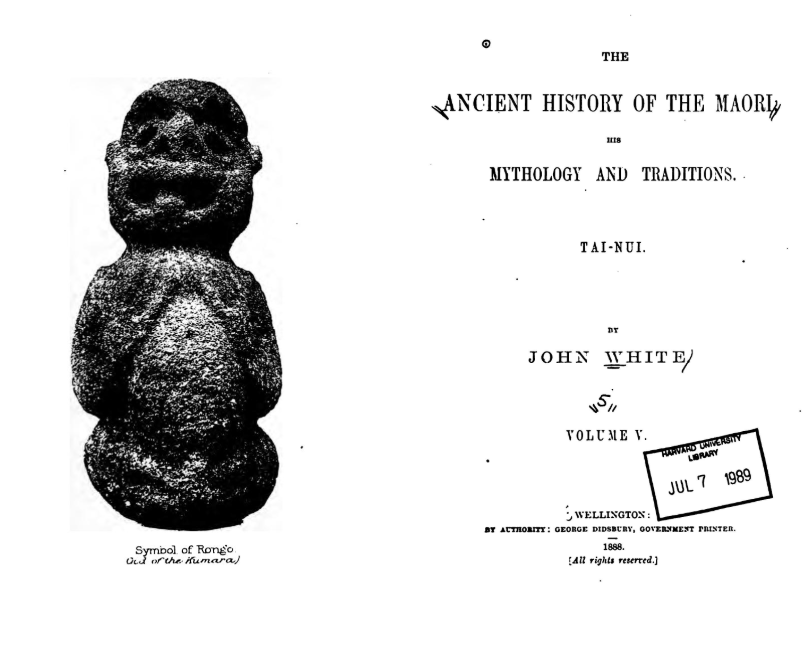The Ancient History of the Maori
Annotation
In this excerpt, an adult Horeta Te Taniwha recounts childhood memories of a cultural encounter with Europeans for a Pakeha researcher. Te Taniwha, as an indigenous child of Aotearoa/New Zealand, participated in one of the first meetings between coastal tribes and the British maritime explorer, Captain James Cook, and his crew. These interactions were written up contemporaneously in Cook's journals and recorded by the artists and gentlemen of science on board Endeavour during its first voyage to New Zealand (November 1769 – March 1770). The published accounts and images would have influenced subsequent European perceptions of Maori people, just as later indigenous responses on island communities throughout the Pacific Ocean would have probably been affected by oral stories of earlier events. Early 19th-century missionaries and linguists successfully developed Maori as a written language but narratives such as this one by Te Taniwha would still be told in Maori and then translated, sometimes with a choice of English terms that had no Maori equivalent. Hence monsters (taniwha) and gods (atua) were part of traditional Maori cosmology but goblins were not. Horeta Te Taniwha recounted his boyhood experiences several times for different researchers with very little inconsistency.
This source extract can invite discussion about the issues to be considered when using adult recollections of childhood, or the influence of a translator's choice of words. Primarily, though, it provides scope for analyzing a relatively rare glimpse of how an indigenous child of Aotearoa/New Zealand first experienced cultural encounter. His frame of reference is Polynesian, of the Pacific, not European. The norms against which he notices similarities and differences are those of his Maori culture (as it had evolved within Aotearoa) and his particular tribe. Auditory perceptions are noticeable: his was a society with no written language but great mastery of detail since the transmission of tribal knowledge and tradition was primarily through chants, oratory, and song.
This source is a part of the New Zealand Childhoods (18th–20th c.) teaching module.
Text
We lived at Whitianga, and a vessel came there, and when our old men saw the ship they said it was a tupua, a god (some unknown thing), and the people on board were strange beings. The ship came to anchor, and the boats pulled on shore. As our old men looked at the manner in which they came on shore, the rowers pulling with their backs to the bows of the boat, the old people said, "Yes, it is so: these people are goblins; their eyes are at the back of their heads; they pull on shore with their backs to the land to which they are going." When these goblins came on shore we (the children and women) took notice of them, but we ran away from them into the forest, and the warriors alone stayed in the presence of those goblins; but, as the goblins stayed some time, and did not do any evil to our braves, we came back one by one, and gazed at them, and we stroked their garments with our hands, and we were pleased with the whiteness of their skins and the blue of the eyes of some of them.
These goblins began to gather oysters, and we gave some kumara [sweet potato], fish, and fern-root to them. These they accepted, and we (the women and children) began to roast cockles for them; and as we saw that these goblins were eating kumara, fish, and cockles, we were startled, and said, "Perhaps they are not goblins like the Maori goblins." These goblins went into the forest, and also climbed up the hill to our pa (fort) at Whitianga (Mercury Bay). They collected grasses from the cliff, and kept knocking at the stones on the beach, and we said, "Why are these acts done by these goblins?" We and the women gathered stones and grass of all sorts, and gave to these goblins. Some of the stones they liked, and put them into their bags, the rest they threw away; and when we gave them the grass and branches of trees they stood and talked to us, or they uttered the words of their language. Perhaps they were asking questions, and, as we did not know their language, we laughed, and these goblins also laughed, so we were pleased. . . .
After the ship had been lying at anchor some time, some of our warriors went on board, and saw many things there. When they came on shore, they gave our people an account of what they had seen. This made many of us desirous to go. . . . We sat on the deck of the ship, where we were looked at by the goblins, who with their hands stroked our mats and the hair of the heads of us children; at the same time they made much gabbling noise in talking, which we thought was questions regarding our mats and the shark's teeth we wore in our ears, and the hei-tiki we wore suspended on our chests; but as we could not understand them we laughed, and they laughed also. . . .
There was one supreme man in that ship. We knew that he was the lord of the whole by his perfectly gentlemanly and noble demeanor. He seldom spoke, but some of the goblins spoke much. But this man did not utter many words: all that he did was to handle our mats and hold our mere [short, flat weapon], spears, and waha-ika [weapon of bone or wood], and touched the hair of our heads. He was a very good man, and came to us—the children—and patted our cheeks, and gently touched our heads. His language was a hissing sound, and the words he spoke were not understood by us in the least. . . .
Credits
Annotated by Jeanine Graham.
